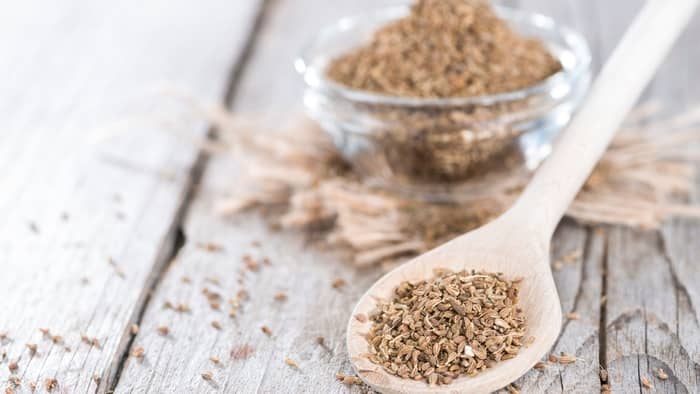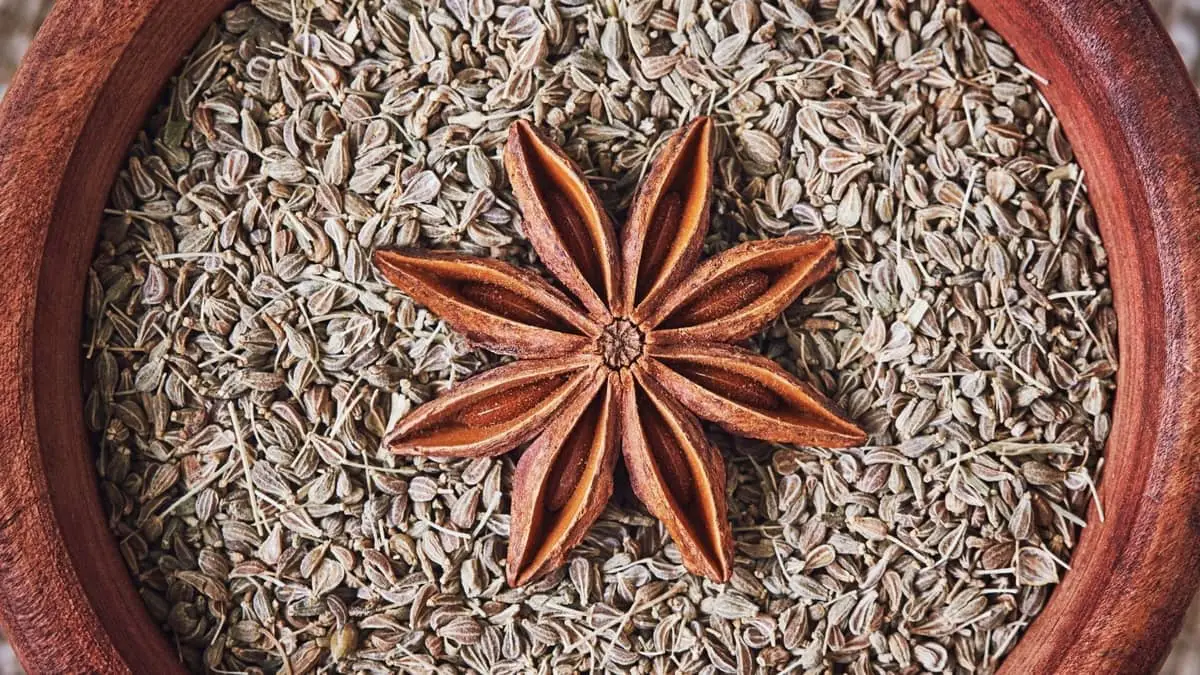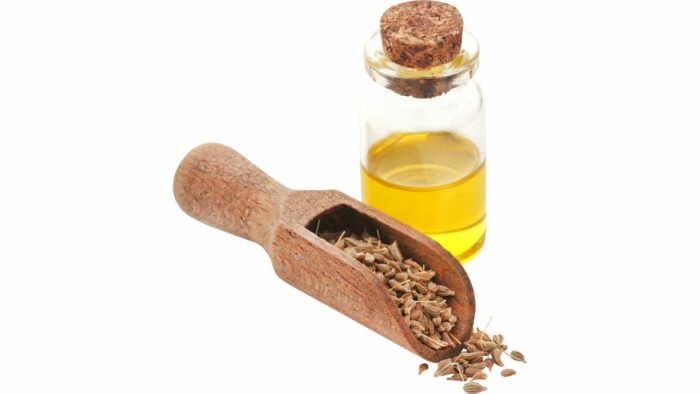Last Updated on February 12, 2023
If you want to elevate the flavor of your baked goods, then consider using anise oil for baking. It is extremely delicious and very versatile. Let’s take a look at how to make anise oil.
Anise oil is one of those ingredients that are extremely underrated. But, by only using a drop or two, you can add a delicious and refreshing licorice flavor to your baked goods, pastries, and savory snacks. It is easy to use and you can even make your own anise-flavored oil.
Anise vs Aniseed vs Star Anise
Before jumping into this article, we felt like it is essential, pun intended, for us to clarify the differences between anise, aniseed, and star anise. It is shocking how many people don’t know or bother to do the research and ultimately put incorrect information out there!
Anise and aniseed are the same ingredient and come from the Umbelliferae family. It is used as a type of herb, mostly in a dried form. Star anise on the other hand comes from the Schisandraceae family. Star anise is a type of dry spice.
The confusion over what these ingredients are is basically because they have a very similar flavors. However, they are different in species and appearance.
That being said, while there is technically a difference between them, a lot of manufacturers of these essential baking oils do use the names interchangeably.
What is Pure Anise Oil?
Anise oil is considered to be an essential oil extracted from the flowering plant, Pimpinella anisum. This oil is a type of extract that adds a very licorice-like flavor and aroma to your baked goods.
Pure anise oil is made by extracting the oil directly from the anise plant. The liquid hasn’t been diluted with any additional ingredients. Furthermore, it has a very clean and concentrated flavor. It is the most authentic flavoring alternative to the actual ingredient itself.
Be wary of any oil that hasn’t been labeled as pure. These products are often diluted with water, regular oil, or alcohol. Their flavor won’t be nearly as clean-cut as pure essential oils.
Is it the Same as Pure Aniseed Oil?
As we have mentioned above, anise and aniseed are the same ingredients.
However, star anise, anise (aka aniseed), and fennel are all entirely different ingredients. They come from different plants and have different fresh and dried forms. Many people get confused between these because they all have a very similar licorice flavor.
Is There a Difference Between Anise Oil and Anise Extract?
Now, many people get confused when talking about oils and extracts. Aren’t they the same thing? While they are used in a similar manner and for similar functions, oils, and extracts are not the same. They differ in the way that they are produced.
Extracts are made by extracting the flavor of an ingredient directly into a liquid base. This liquid base is usually alcohol. It has a thin consistency (like alcohol does) and is relatively strong in flavor. Much stronger than an essence at least. When the item containing the extract is baked, the alcohol is cooked off and completely evaporates, leaving only the flavor of the extract.
A flavoring oil, like pure anise oil, is squeezed out of the plant or ingredient. So, naturally, these oils have a much more intense and authentic flavor as compared to their extract counterparts.
Now, some extracts use oil. However, they are almost always diluted with added alcohol. It is best to check products labeled as “extracts” or “oils”. Always make sure which ingredients they contain.
Furthermore, anything labeled as “pure” cannot contain anything other than essential oil.

What Can You Do With Anise Oil in Cooking?
There are actually a few uses for anise oil in baking. But, make sure you buy food-grade anise oil that is safe to be used in cooking. These oils have been processed in a way to makes them stable when they are being heated.
In baking, pure aniseed oil can be used in sweet treats like cakes, muffins, cupcakes, and cookies. However, you can also use it to make savory snacks like crackers and even flatbreads.
The possibilities are endless and the only restriction is the flavors you are pairing the anise oil with.
Fruit flavors that pair incredibly well with anise oil include oranges, grapefruits, pineapples, cantaloupes, apricots, mangoes, figs, and plums.
Then, you can also pair vegetables with anise. The best vegetable pairings include asparagus, beetroot, rhubarb, and parsnips.
And then, of course, you can combine the anise oil with other spices and herbs including saffron, chili, peppercorns, cumin, cinnamon, and basil.
An easy starting point for experimenting with the flavor of anise is by making this simple Poached Pear recipe. Substitute the star anise with anise oil to give you an idea of the flavor profile you are working with. You can also easily add any of the other ingredients mentioned above.
How Do You Make Anise Oil for Baking?
So, you most likely don’t have the equipment to extract the anise oil from the actual plant. But, that doesn’t mean you cannot make an anise-flavored oil. A flavored oil is any type of oil that has been infused with an ingredient. This is similar to how extracts are alcohol that is infused with an ingredient.
LorAnn Anise Oil Super StrengthNatural Flavor, 1-ounce bottle
To make anise-flavored oil, finely grind about 2 ounces (60 grams) of anise (aniseed). Then, heat a pan over medium heat and toast the ground anise.
Next, in a pot, combine the toasted anise with 1 cup of neutrally-flavored oil, like canola or sunflower oil. Heat the oil mixture for about 10 minutes. Remove it from the heat and allow it to completely cool.
Once cooled, transfer the anise-flavored oil to a glass jar and allow it to further infuse for at least a day. You can keep it in the fridge or at room temperature.
Best Anise Oil for Baking
If you’re looking for the best anise oil when it comes to using it for baking, there are several options you can choose from. Here are some of our top picks.
Olive Nation Pure Anise Oil
This oil is available in varying sizes and prices start at around $4.99 for a 2 fluid oz bottle. This pure anise oil is not just Kosher and gluten-free, but also non-GMO and vegan friendly; meaning it’s suitable for a range of dietary lifestyles. The anise oil from Olive Nation is from the star anise plant and is perfect for a range of baking and cooking recipes. It has a shelf life of around 18 months when stored correctly.
Anise Essential Cooking Oil By RV Essentials
This oil comes in differing sizes and prices start at around $16.99 for a 1.69oz bottle. What’s great about this option is that it’s completely natural and doesn’t contain any additives or additional preservatives. It’s one of the most reputable brands and as well as being used for baking, can also be used for aromatherapy too. This oil is very strong and doesn’t require much at all.
LorAnn Super Strength Natural Oil
Again, this oil comes in varying sizes and prices start at around $10 for a 1oz bottle. Another pure essential oil comes both kosher and gluten-free; meaning it’s perfect for a range of dietary profiles. If you like that licorice flavor, this is the option for you. In comparison to traditional extracts, like vanilla, this oil is four times stronger! So be sure to use it sparingly in your baking.
How to Make Anise Extract
If you’re looking to make your own anise extract from the comfort of your home, then look no further. This doesn’t require many ingredients at all, but it is quite a lengthy process. The ingredients you’ll need for this recipe are:
- 2 teaspoons of dried fennel seeds
- 8oz of vodka
- glass mason jar
Now all you need to do is:
Drop the fennel seeds into your mason jar and then pour in your vodka. Place the lid tightly on top of your jar. Shake several times a day for the first week. After this time, you can leave it in a cool, dry place and allow it to infuse for a few months, for the best results. Remember to shake your jar around once a week. Use as needed.
Anise Oil Benefits
Adding anise oil to your diet comes with a range of health benefits. Some of the best health benefits include:
- it’s full of nutrients, such as iron and calcium. A tablespoon of anise seed contains just 23 calories and less than 1g of fat. It also contains 3g of carbs, 1g of protein, and 1 g of dietary fiber.
- aids pain. Anise oil has been known to help joint and muscle pain. It’s also known to be an effective anti-inflammatory.
- reduces symptoms. It can reduce symptoms of many issues, such as depression, menopause, and even stomach ulcers!
- blood sugar levels. It can be an effective way of neutralizing your blood sugar levels and having a positive effect on them.
What Are the Ingredients in Anise Oil?
The main ingredients in anise oil are either anise seed or star anise pods. The overwhelming flavor is licorice.
How to Substitute Anise Oil in Recipes
If you’re looking for a way to substitute anise oil in your recipes, it’s super easy. For every 1/4 teaspoon of anise oil, you’ll need 1 teaspoon of anise extract, 2 teaspoons of ground anise seed, 1 pod of star anise, or 1-2 tablespoons of anise liquor.
Final Thoughts on How to Make Anise Oil
I hope this post has helped you to learn how to make anise oil for baking. As you can see, this oil is much more complex than most people think. It has a wide variety of uses and is packed with flavor. If you have any questions, please feel free to ask us in the comments below. And, if you know of anyone that might find this article helpful, share it along!

Lindy Van Schalkwyk is a culinary specialist with a background in Advanced Cooking, Advanced Pâtisserie, Media Communications and Nutrition. She has gained invaluable experience in the culinary industry having worked in some of the top restaurants in Africa in 2016 and 2017. Her expertise in nutrition has enabled her to develop recipes for special dietary needs. In 2018, Lindy began working in the Food Media industry, focusing on recipe development, recipe writing, food writing and food styling.



